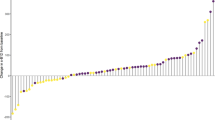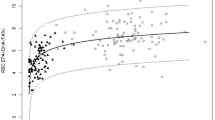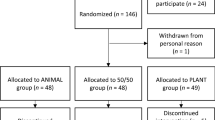Abstract
Objectives
The aim of the present study was to investigate whether the following four markers: vitamin B12, selenium, vitamin D, and parvalbumin may be used as compliance markers for fish intake.
Methods
Blood samples from a randomized cross-over herring intervention study (n = 32) were analysed by HPLC and immunochemistry. The criteria were that plasma or serum concentrations of candidate compliance markers after the herring diet should increase significantly compared to starting concentrations. In addition, the reference meat diet should not yield an increase in plasma concentration of the candidate marker.
Results
Vitamin B12 and selenium met the set criteria for indicating a correlation between the marker and fish intake with significant increases in serum concentrations at 8.9 % (p = 0.008) and 4.6 % (p = 0.02), respectively, after a 6-week herring intervention (5 meals a week). Parvalbumin and 25-hydroxy vitamin D3 levels did not increase significantly after the herring interventions.
Conclusions
Vitamin B12 may be suitable as a compliance marker for fish intake. Although selenium also met the criteria, the change in selenium serum concentrations was small compared to the change in vitamin B12 levels.


Similar content being viewed by others
References
Undeland I, Ellegård L, Sandberg A-S (2004) Fish and cardiovascular health. Scand J Nutr 48:119–130
He K, Song Y, Daviglus ML, Liu K, Van Horn L, Dyer AR, Greenland P (2004) Accumulated evidence on fish consumption and coronary heart disease mortality: a meta-analysis of cohort studies. Circulation 109(22):2705–2711
Kris-Etherton PM, Harris WS, Appel LJ, for the Nutrition C (2002) Fish consumption, fish oil, omega-3 fatty acids, and cardiovascular disease. Circulation 106(21):2747–2757
Vries J, Antoine J-M, Burzykowski T, Chiodini A, Gibney M, Kuhnle G, Méheust A, Pijls L, Rowland I (2013) Markers for nutrition studies: review of criteria for the evaluation of markers. Eur J Nutr:1–15. doi:10.1007/s00394-013-0553-3
Kobayashi M, Sasaki S, Kawabata T, Hasegawa K, Akabane M, Tsugane S (2001) Single measurement of serum phospholipid fatty acid as a biomarker of specific fatty acid intake in middle-aged Japanese men. Eur J Clin Nutr 55(8):643–650
Hjartåker A, Lund E, Bjerve KS (1997) Serum phospholipid fatty acid composition and habitual intake of marine foods registered by a semi-quantitative food frequency questionnaire. Eur J Clin Nutr 51(11):736–742
Johansson S, Lönnqvist A, Östman S, Sandberg AS, Wold AE (2010) Long-chain polyunsaturated fatty acids are consumed during allergic inflammation and affect T helper type 1 (Th1)- and Th2-mediated hypersensitivity differently. Clin Exp Immunol 160(3):411–419. doi:10.1111/j.1365-2249.2010.04107.x
Hou L, Lian K, Yao M, Shi Y, Lu X, Fang L, He T, Jiang L (2012) Reduction of n-3 PUFAs, specifically DHA and EPA, and enhancement of peroxisomal beta-oxidation in type 2 diabetic rat heart. Cardiovasc Diabetol 11(126):1–8
Johansson S, Wold AE, Sandberg AS (2011) Low breast milk levels of long-chain n-3 fatty acids in allergic women, despite frequent fish intake. Clin Exp Allergy 41(4):505–515. doi:10.1111/j.1365-2222.2010.03678.x
Kyle DJ, Schaefer E, Patton G, Beiser A (1999) Low serum docosahexaenoic acid is a significant risk factor for alzheimer’s dementia. Lipids 34(1):S245–S245. doi:10.1007/bf02562306
Aldamiz-Echevarria L, Prieto JA, Andrade F, Elorz J, Sojo A, Lage S, Sanjurjo P, Vazquez C, Rodriguez-Soriano J (2009) Persistence of essential fatty acid deficiency in cystic fibrosis despite nutritional therapy. Pediatr Res 66(5):585–589
Amiano P, Dorronsoro M, de Renobales M, Ruiz de Gordoa J, Irigoen I (2001) Very-long-chain omega-3 fatty acids as markers for habitual fish intake in a population consuming mainly lean fish: the EPIC cohort of Gipuzkoa. Eur J Clin Nutr 55:827–832
Lloyd AJ, Favé G, Beckmann M, Lin W, Tailliart K, Xie L, Mathers JC, Draper J (2011) Use of mass spectrometry fingerprinting to identify urinary metabolites after consumption of specific foods. Am J Clin Nutr 94(4):981–991
Stella C, Beckwith-Hall B, Cloarec O, Holmes E, Lindon JC, Powell J, van der Ouderaa F, Bingham S, Cross AJ, Nicholson JK (2006) Susceptibility of human metabolic phenotypes to dietary modulation. J Proteome Res 5(10):2780–2788. doi:10.1021/pr060265y
Rasmussen LG, Winning H, Savorani F, Toft H, Larsen TM, Dragsted LO, Astrup A, Engelsen SB (2012) Assessment of the effect of high or low protein diet on the human urine metabolome as measured by NMR. Nutrients 4(2):112–131
Brantsæter AL, Haugen M, Thomassen Y, Ellingsen DG, Ydersbond TA, Hagve T-A, Alexander J, Meltzer HM (2010) Exploration of biomarkers for total fish intake in pregnant Norwegian women. Pub Health Nutr 13(01):54–62
Benton D (2008) Micronutrient status, cognition and behavioral problems in childhood. Eur J Nutr 47(3):38–50. doi:10.1007/s00394-008-3004-9
Mollin DL, Pitney WR, Baker SJ, Bradley JE (1956) The plasma clearance and urinary excretion of parenterally administered 58CoB12. Blood 11:31–43
Stabler SP, Allen RH (2004) vitamin B12 deficiency as a worldwide problem. Ann Rev Nutr 24(1):299–326. doi:10.1146/annurev.nutr.24.012003.132440
Berr C, Akbaraly T, Arnaud J, Hininger I, Roussel AM, Barberger Gateau P (2009) Increased selenium intake in elderly high fish consumers may account for health benefits previously ascribed to omega-3 fatty acids. JNHA—J Nutr, Health Aging 13(1):14–18. doi:10.1007/s12603-009-0003-3
Lindqvist HM, Langkilde AM, Undeland I, Sandberg A-S (2009) Herring (Clupea harengus) intake influences lipoproteins but not inflammatory and oxidation markers in overweight men. Br J Nutr 101(03):383–390
Lindqvist H, Sandberg AS, Undeland I, Stener-Victorin E, Larsson BM, Sannaveerappa T, Lönn M, Holmäng A (2009) Influence of herring (Clupea harengus) and herring fractions on metabolic status in rats fed a high energy diet. Acta Physiol 196(3):303–314
USDA National nutrient database for standard reference
Baik HW, Russell RM (1999) Vitamin B12 deficiency in the elderly. Ann Rev Nutr 19(1):357–377. doi:10.1146/annurev.nutr.19.1.357
Viljakainen HT, Palssa A, Kärkkäinen M, Jakobsen J, Cashman KD, Mølgaard C, Lamberg-Allardt C (2006) A seasonal variation of calcitropic hormones, bone turnover and bone mineral density in early and mid-puberty girls—a cross-sectional study. Br J Nutr 96(01):124–130
Kuehn A, Scheuermann T, Hilger C, Hentges F (2010) Important variations in parvalbumin content in common fish species: a factor possibly contributing to variable allergenicity. Int Arch Allergy Immunol 153(4):359–366
Teerapornpuntakit J, Dorkkam N, Wongdee K, Krishnamra N, Charoenphandhu N (2009) Endurance swimming stimulates transepithelial calcium transport and alters the expression of genes related to calcium absorption in the intestine of rats. Am J Physiology—Endocrinol Metabol 296(4):E775–E786
Acknowledgments
The present work was funded by the Region of Västra Götaland (RUN612-0026-08 and RUN612-1102-08) and the Swedish Board of Agriculture (031-0267-08, European Fisheries Fund, Investing in sustainable fisheries). On behalf of all authors, the corresponding author states that there is no conflict of interest. The human intervention study was approved by the Ethical review board, Gothenburg. The study have therefore been performed in accordance with the ethical standards laid down in the 1964 Declaration of Helsinki and its later amendments.
Author information
Authors and Affiliations
Corresponding author
Rights and permissions
About this article
Cite this article
Scheers, N., Lindqvist, H., Langkilde, A.M. et al. Vitamin B12 as a potential compliance marker for fish intake. Eur J Nutr 53, 1327–1333 (2014). https://doi.org/10.1007/s00394-013-0632-5
Received:
Accepted:
Published:
Issue Date:
DOI: https://doi.org/10.1007/s00394-013-0632-5




